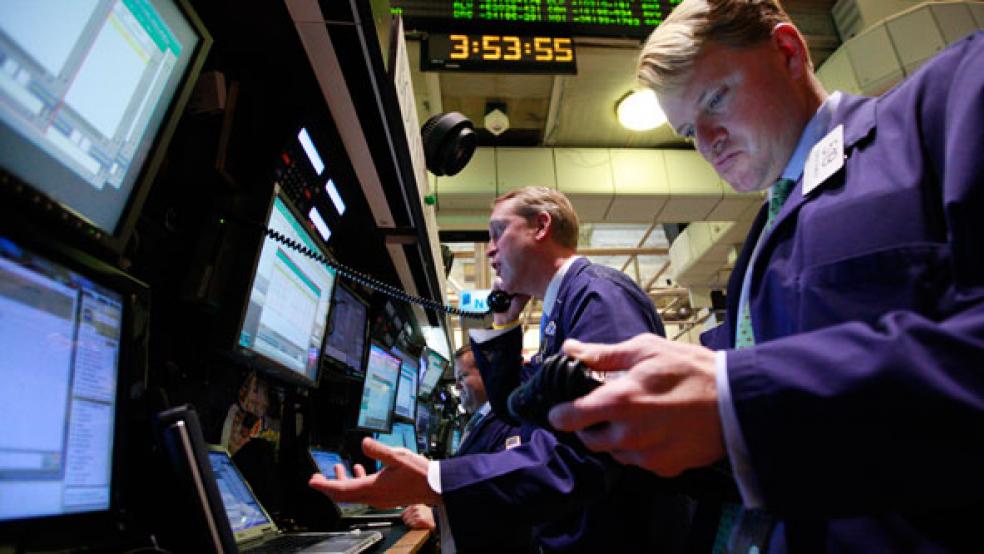The first quarter – the best first quarter for stocks in 14 years, and only the ninth time in the last 60 years that gains in the opening three months of the year have exceeded 10 percent – already seems like ancient history.
But what comes next? Is the 12 percent first-quarter surge in the S&P 500 index a harbinger of a blockbuster year that will propel major market indexes to new all-time highs? Or was the first quarter simply a final hurrah, with the stock market about to turn sour in response to a failure on the part of the economy in the U.S. and worldwide to continue to show signs of strength?
Certainly, today’s open (stocks sank more than 1 percent right out of the gate in reaction to Friday’s weaker-than-expected jobs report and worries about Chinese inflation) isn’t an encouraging sign. And last week seemed to indicate that jaundiced or fearful investors aren’t willing to stick around, preferring to yank at least some of their profits off the table and clear out while the going is still good.
RELATED: Expectations High for Bank Earnings
Maybe the pendulum is simply swinging back to the so-called “risk off” trade after riskier stocks – those that had been laggards, or whose metrics put them in the bottom deciles in categories like their price/book or price/sales ratios – fared best during the first quarter, as Birinyi & Associates pointed out in their analysis of what strategies paid off most handsomely for investors during those months. The previous market favorites – stocks paying the fattest dividends and that thus appeared to offer additional returns and stability – brought up the rear. The 50 stocks with the biggest yields in the S&P 500 returned a mere 3.2 percent during the first quarter.
Of course, investing based on what has worked in the recent past is about as sensible as driving while navigating based on the view in your rear-view mirror. But a glance at what did and didn’t work in the first quarter may provide some guidance of a more contrarian variety.
When investors were buying stocks at a frenetic pace in the early months of 2012, they were responding, in part, to better-than-expected earnings from those companies for the fourth quarter of 2011, as well as to some stronger-than-expected economic data and a relaxation of worries about events in the Eurozone. What is out there that is likely to drive stock prices higher still, particularly among the riskier stocks that have experienced the biggest jumps in their valuations? The economic data may not be any more encouraging, even if it isn’t bearish; while the Eurozone may be stable, that stability is precarious and it’s going to take a long while for economic growth to rebound in that part of the world.
Hanging over everything is the outlook for corporate earnings. The annual “earnings season” officially kicks off tomorrow when Alcoa (AA) reports its results for the first quarter – and analysts are predicting that after a profit of 28 cents in the first quarter of 2012, this year, the metals industry giant will post a loss of 4 cents a share. Some companies that have reported results already have been bullish about their prospects, such as homebuilder Lennar (LEN), which reported profits of 8 cents a share, roughly double what analysts had forecast it would earn.
More gains like that may be harder to come by in the first quarter, at least if you believe analysts who are calling for earnings for the S&P 500 companies to rise only 3 percent for the period. For stock prices to rise as sharply in the second quarter as they did during the first, actual results will have to be significantly stronger than those analysts predict, across the board: The earnings surprises will have to be large enough and frequent enough to persuade investors to abandon their anxiety and continue buying.
The odds of an across-the-board 12 percent jump in the value of the S&P 500 during the second quarter appear low. What is much more likely to happen is that individual sectors or industries will experience outsize gains, while the overall index may be more volatile and finish the quarter in June with only modest gains. Stocks are probably still the place to park your money – given rock-bottom interest rates and the fact that these rates are only likely to move in one direction, there is little point in putting cash into bonds – but it seems likely that a careful stock-picking strategy is likely to generate higher returns than simply throwing money into the market as a whole, or betting that the highest risk stocks will continue to generate the highest returns. Prudence, not valor, may carry the day.




